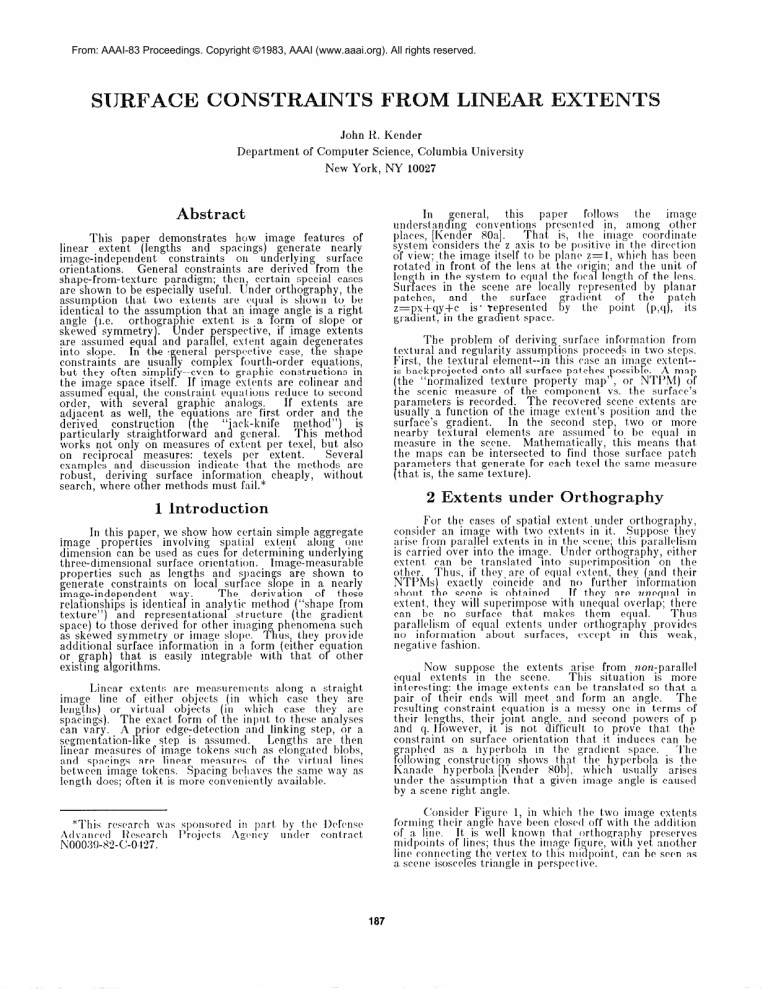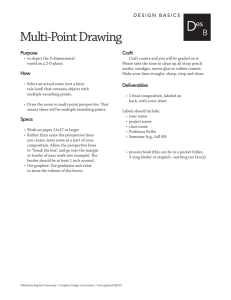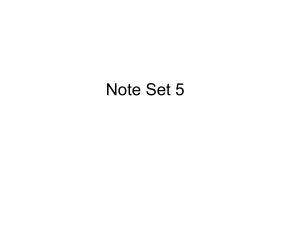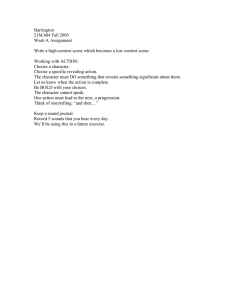
From: AAAI-83 Proceedings. Copyright ©1983, AAAI (www.aaai.org). All rights reserved.
John R. Kender
Department
of Computer
Science,
Columbia
University
New York, NY 10027
Abstract
This pa.per demonstrates
how image features
of
linear
extent
(lengths
and spacings)
encrate
nearly
constraints
on un cferlying
image-independent
surface
General constraints
are derived from the
orientations.
shape-from-texture
paradigm;
then. certain special cases
are shown to be especially useful. Under orthography,
the
assumption
that two extents
are equal is shown to be
identical to the assumption
that an ima e angle is a right
angle (i.e.
orthogra
hit extent is a s orm of slope or
erspective,
if image extents
skewed symmetry
. e nder
are assumed equa 1 and para Ii cl, extent again de enerates
In the * eneral perspective
case, t i! e shape
into slope.
constraints
are usua fi y complex
fourth-order
equationas,
but they often simplify--even
to graphic constructions
m
If image est ents are colinear and
the image space itself.
assumed e ual, the constraint
equations reduce to second
order,
wit ‘fi several
graphic
analogs.
If extents
are
adjacent
as well, the e uations are first order and the
“‘acli-knife
method”)
is
derived
construction
4 the
particularly
straightforward
an d general.
This method
works not only on measures of extent per texel, but also
on reciprocal
measures:
texels
per extent.
Several
examples
and discussion
indicate
that the methods
are
robust,
derivin
surface
informat ion cheaply,
without
search, where otB er methods must fail.*
1 Introduction
In
general,
this
follows
the
image
paper
understandmg
conventions
presented
in, among
other
That
is, the image coordinate
places, [Kender
8031.
system considers the z axis to be positive in the direction
of view;.the
image itself to be plan0 z=I, which has been
rotated In front of the lens at the ori in; and the unit of
len th in the system to equal the foca 7 length of the lens.
E3;3c;~
i;,tdhe scene are locally rypresc$edthSy
play;;;
t
the
surface
gratllcnt
z= x-&y+c
is* re resented
by the point
(p,q f , its
gra s ient, in the gra %lent space.
The problem
of derivin,. 0- surface informst ion from
textural and regularity assumptions
proceeds in two stc>ps.
First. the textural element--in
this case an im;ie;e cstcnt-is backprojected
onto all surface patches ,yossibl&. A map
the “normalized
texture property
map
or NTI’M) of
I he scenic measure
of the comnoncnt
vk. the surface’s
parameters
is recorded.
The r&overed
scene extents arc
usually a function of the image exfent’s position and the
surfaee’s
gradient.
In the second step, two or more
nearby
textural
elements
are assumed
to be equal in
measure in the scene.
Mathematical1
this means that
the ma s can be intersected
to find t x bse surface patch
arame r ers that generate for each tcxel the same measure
f that is, the same texture).
2 Extents
under
Orthography
For the cases of spatial extent under orthogra
hy,
consider an image with two cxtcntq in it. suppose
f hey
arise from parallel extents in in the scene* this parallelism
is carried over into the image. Under ortilography,
cithcr
extent
can be translated
mto supcrimposltion
on the
other.
Thus, if they are of equal tlxtent, they and their
NTI’hls
exactly
coincide
and no further
in\ ormation
about t 1IC scene is obtained.
If they are unequal
in
extent, they will superimpose
with unequal overlap; there
can be no surface
that
makes
them
equal.
Thus
parallelism
of equal extents under orthography
provides
no information
about
surfaces,
cxccpt
in this weak,
negative fashion.
raph
tha.t is easily
or
exis &ing a 1gorithms.
integrable
with‘ that
of other
Linear extents
are measurements
along a straight
image line of either objects
(in which case they are
lengths)
or virtual
objects
(in which
case they
are
spacings).
The exact form of the inpllt to these analyses
can vary.
A prior edge-detection
and linking step, or a
segmentation-like
step is assumed.
Lengths
are then
linear measures of image tokens such as elong:atcd blobs,
and spacings
are linear measures
of the vlrfual
lines
betlvcen image tokens.
Spacing bch:~vcs the same way as
length does; often it is more conveniently
available.
Now suppose
the extents
arise from non-parallel
equal extents
in the scene.
This situation
is more
interestin
: the image extents can IX translated
so that a
pair of t Blcir ends will meet. and form an angle.
The
resulting
constraint
equation is a messy one in terms of
their lcn ths, their joint an Ic, and second
powers
of p
and q. I Powever,
it is not 5 ifficult to prove that, the
constraint
on surface orientation
that it induces can be
raphed
as a hyperbola
in the gradient
space.
The
sallowing
construction
shows that the hyperbola
is the
&made
hyperbola
[Iicnder
8Ob], ivhich
usually
arises
under the assumption
that a given image angle is caused
by a scene right angle.
(:onsidcr Fi urc 1, in which the two image extents
forming their ang Bc have been closc~l off with the addition
of a line.
It is well known that orthogra
hv
reserves
midpoints of lines; thus the image fi,<-ure, WI*tY
11uye If another
line connecting
the vertex to this IHI($1point, can be seen as
a scene isosccles triangle in pcrspcct i\r+.
Given this, the angle
base in the scene must be a
The surface
nssumpt ion.
Ecual cxttlnts in
d(~rivctl
thcref~,rc~ eit \ lcr give trivial
known cases of image slope
formed b the altitude to the
right ang Pc: this is the Kanadc
constraint
then is identicallv
the image under ortho raphjr
results, or reduce to a5 ready
and angle.
imngc>, their pairs
vanishing
points.
constraint
in the
oint
a vanishing
a gradient
r p,q)
z;T
suct;ci;ne?r
in
.Y
.
orient ation.
3.2
Equal
of sides ~311 be t~xtcndcd to derive tlvo
Each vanishing
point implic3 a linear
gradient space: if an ima e point (x y) is
of a surface, then the sur s act must i ~nvc
which sntisfles. px+qy=l
( [Shafer. 831).
constraint:
uniquc~l define a vanishing
the
surface
turn
uniquely
Befmes
and Colinear
Assume now that the image extents did not arise
There seems to be only one
from par:ill<~l scene extents.
those when the scene
other sim lifying set of cases:
componcn rs are colincar. Interestingly,
these cases do not
reduce the problem
to one of image slopes again, as
colincar extents have only one slope held in common.
The imaEes of colinear scene components
are also
colincar.
The”rcverse
is not true, thou’gh the heuristic
positing of that truth often is most useful.
It would be
yet another preference
heuristic,
similar to those used in
for example,
other
contexts
in image understanding:
actual
scene
patch
nearb
image
pixels
arise from
neigh l ors (sha e from shading , nearly ri ht angles arise
from scene rig fit an lcs (skcwec 1 s mmctry ‘i, near-parallels
arise from parallels $one form of s iI ape from texture), etc.
Figure
1:
Equal
3 Extents
extent
under
is skewed
symmetry.
Perspective
The ima e configuration
in the most general case
reduces to the Bollowing.
Four points lie on the horizontal
pith I3, (2, and
image line at hei -lit y’ they are A=(a,y)
D defined similar (iy). ?‘hese four points defme two lrn+fe
R=(d-c
, rcsrectivcl
.
ie
extents, . I,=( b-a)
and
assumption
of collnearily allows the NTI his of t 7le extents
to be put intp corr-espondrnce
easily: they are already in
the pro er orlentstlon,
due to the one shared image slope.
terms in S(p,y), equatmg
Since tie
P 7 also share identical
vields a surface constraint
that reduces to
the NT&
second order-in p and q:
(I-pa-qy)(l-pb-su)/L
= (l-pc-(lu)(l-pd-~ly)/R
The
lencth
of the
induced
surface
extent
is
calculated
in t?lc scene by the usual Euclidean
metric,
yielding a complex NTPM:
Although this equation can bc exactly solved, it has
a simplifying
graphic construction
that can be drawn in
the image space itself
dircctlv
yielding
the vanishing
point(s).
Rewrite it in the folloGng form:
(X-a)(X-b)/L
Theoretically,.
this function
as usable in its raw
That is, given two extents
in an imaae under
form.
en&ate
the
it is possible
to
ccnf ml pers 3&tiVe,
appropriate
64TPMs for both (sub’ect to t5 leir position
and orientation),
alIt to intersect
t r’
leir graphs, as if they
The result, would be a
wert’ 1Iough accumulator
arrays.
would
which
sf.4
of
surface
0Cientat ions
small
simult :~ncol~sly normalize the two induced surface extents
However,
in nearly all cases, this
to ccj~ial measure.
invol\,rs the solutions to constraint
equations that are of
fourth order in p and q. Only a few ima e configurations
+h e ones that do
gcncratc
simpler surface constraints.
simplify have the added benefit that they appear to be
relatively common.
3.1 Equal
and Parallel
First assume that image estents
arose from scene
components
that were not only ccual in measure,
but
A simple construction
were ,nrallcl on the scene surface.
will s 1low that once again the image conflguration
can be
hnntllct1 solely bv collsitlerations
of ims e slope.
Two
equal and pnrnllcl scene lines form a para Ii elogram; in the
= (X-c)(X-d)/R,
where X = (I-qy)/p
ec uation
then scene
If X satisfies
the constraint
Furt fi er th’iq is a very
extents
are e ual a.s desired.
the forma! definition
that
desirable
X: i1 a&o satisfies
oint.
Ei\;+qy= 1, that is, the point (X,y) is a vanishing
al I” that
ote that (X y) 1les on the line of colinearity;
must be calculated
is t,he value of S itself. Formal1 r, the
o 8 two
equation
is of the form of the intersection
parabolae.
The left parabola has value 0 at both a and b,
and a minimum value of L/4 midway between them. The
right parabola
is exactly of the s;lmc shape, except for
sealing (its midpoint minimum is R/4 . Thus, the value of
the
X can be EraDhicallv
determinct 1 by drawing
and finding their intersection.
arabolae
on “th6 imaie,
Notice that the mathematics,
as ~~~11as the construction,
inds a vanishing point between b and c, where the image
lengths are on opposite
sides of any vanishing line.)
P
The parabola metshod can be refined in the followin
way. The parabolae are on1 constrained
to pass throug $1
the point pairs; their exact sflape is not critical, as long as
they can be mutually
the parabolae
are similar (i.e.
scaled . Further,
since the value of x is a purely formal
one, t iie pnrabolac
can 1)~ imaginc>tl to be tlrn\vn off of
the image plant: that is, either par:ll)ola can be though of
as cstcnding
into the -z axis direction.
the value
of X on either
R’lore a propriately,
parabola can f)e considered
as an image feature in its own
right.
The calculation
is really a type of local feature
with with each position
on the line of
assignment,
colinearity
being
assi ned two simultaneous
features.
are identical
is the
That position
where f he features
vanishing point.
Parabolae
row very quickly, however.
This can be
compensated
for 9 ormally by taking the s uare root of this
The assignment
of va ? ues is now via
image feature.
hyperbolae
of similar sha e, which. grow a proximat.ely
linearly.
They also have t i! e aesthetlc advan Fage of being
undefined
within
the ima e extents
themselves,
the
interior of which being one p5 ace where a vanishing point
In a pinch, the hyperbolae
can also be
ought not be.
approximated
by their asymptotes,
which, being strlctl
linear
are easier to compute.
For example,
the le r t
hyperbola
is scrt((X-a)(X-b)/L
; its asymptotes
ori ina?;
at the left texe Iss midpoint, an d have slopes of sqrt( 6
-sqrt(L)
(see Figure .a).
Still oth$r modificat:ions
and
approsim;i;Ts
of this formal equatlT;r are posslblc; they
would
to
be
analyzed
accuracy
and
computational
efficiency.
vanishing point
Figure
really
inverse
Figure
3.3
2:
Equal,
The hyperbola
Colinear,
and asymptote
methods.
and Adjacent
(X-a)/L
= (I-pd-qy)/R
formal
= (X-d)/R,
method
as above,
it can
an
image
for vanishing
feature:
it
points.
is sealen
Method
The jack-knife
method has 311 interestin
clxt(bnsion.
The primary
heuristic
assumption
rc>cluired 5 or its use
rc~quircs only that image oxtcrits :iris;c from oqu:>l surface
extents; however, what is meant by oxtent can be tlofint~d
In particular,
a series of N cxtcnts laid
in rriany ways.
colincarly
end to end on a surface can bc con~itlcrcd
either as a one extent of length N or N of 1~11 ,th one’ (or
combinations
.
runs oT niult iple
many other
Ott (‘I1
extents
can
be obtainct 1 bv lookin
for rtlpc9t otl
distinguishing
events along nri ftrbit rary 7 inc through tlira
imngc. (Strong cdgcs of the s;lmc polarity, say.)
'4:
same
implement
method
depth.
3.4 A Reciprocal
F
L3y the
rewritten
as:
does
“Jack-knife”
These methods
are formal; :ts with the parabola
method, other modifications
of the constraint
equation arc
It should be notr>d fhat the jack-knife
possible as well.
equation
can also be derived
from the ap hcntion
of
methods of projective
geometry: tit her t hroljg Y1 t hc crossratio, or t,hrou h the appropriate
nine-point
geometric
method appnrcntly
cannot,
construction,
+ he parabola
however, as it deals with five points at a time.
The last special case is the simplest, but perhaps the
most powerful.
Suppose that two colinear and a~~ncent
image extents
are derived from two colinear,
adjacent,
and equal scene components.
That is, as in Figure 3, the
oints B and C have merged.
Then t,he constraint
given
or the general
four-point
colinear
case simplics
evrn
further since B=C, to that of a linear constraint
in p and
(l-pa-qy)/L
3:
be
where X = (I-qy)/p
The jack-knife
method,
as given, would try to
normalize
the extent of the cntirc run.
Ijut under the
assumption
that the events form ;I tc5ture,
1h(b iric~thod
can be extcndcd
to normolizc* etrcll ewut as \vclI. It tlocs
this by simpl
dividing norm:llizctl
run clxtclnt hy c>vcnt
count to get ti e “av(~rage” tkstcnt of a unit rY(‘nf: Thus,
given a run of eveills, thtl estcndc~tl mct hod tiivlclc5 t Ircb
l:it hclr side is the equation of a line. With exactly
the MIHC flexibilities of the parabola scheme above, these
lines can bc plotted
in the image s jace (see Figure 3).
‘l’h:~t is, they can extend out of t fie image in the -z
direct ioll; they can be mutually
scaled; X can again be
consitlc~r~~tl an image feature, labeling each position on the
lill(l of colillcb:lrity. \villl ;I two-tuplC> of features.
fZs l)cforC,
ttlr v:ini\hirlg
polnf occurs when t Ire fctiturcs arc equal;
this occi~rs al X=(1,(1-rra)/(I,-r~).
189
(( I-pa-qy)/L)/l==((
I-pd-qy)/R)/r;
1 and
r are event
COllI~tS
Note that the run can be s lit in many places, and
that the modified equation can. E:e solved by any of the
grn )hic techniques
given inrnkyi a;k-knife
method (with I,
fl
to
L/l
and
R/r
appropriately
an d II
respectively.)
? he optimal ways to split the run would
have to be analyzed.
The ‘ack-knife
method
is based on a measure of
method
uses texels-percx t en t-per- i cxel; this reciprocal
The reciprocal
method
has many advantages.
extent.*
Dctectmg
the events can be done by detectors
of fixed
Within
each detector,
event
image size and location.
counts cm
be recovered
by simple pattern
recognition
techniques.
The final computation
is simple.
In effect,
the shape constraints
under this method come from simple
feature detectors.
3.5 Discussion
and Implementation
Figure
Jack-knife
rnethods
on a synthetic
texture.
justified
!$ere.isollted
Control is far more difficult.
Exce~-$C;:
scenes
L
well-defined
surfaces
sophistication
is necessary in apportioning
belief’ amongst
the results
of several
such
methods’
simultaneously
calculated
results.
Inte rating the algorithms’ computed
vanishing
points--crrorfu 7 and often contradictor
--into a
single surface synthesis appears to be a major cha i;lenge.
Example
methods
The true beauty of the jack-knife
from the fact that they are one-step and robust.
4:
comes
Acknowledgements
I thank Kcrny Calawa
for her raphic skills. hIark
Moerdler implemented
the a 7gorithm s5rown in Figure 4.
The jack-knife
methods succeed even with difficult
textures or orientations.
As in the wave texture of figure
the
vanishing
line direction
has no
4, sometimes
measurable
regularity* regularit r-based tilt-searches
must
The jack-k&e
metho x s will return
a proper
fail
vanishing point however, as long as they are not aligned
The jack-knife
methods
even
with the vanishing
dine.
work without search on frontal ((p,q)=(O,O)) textures,. in
which eatery direction
exhibits ima e textural
regularity.
the jack-knife
met f:rods properly
return
In this case
infinite vanishing points.
References
Bajjcsy 761 Rajcs
R., and Lieberman
L. “Texture
L‘radient as a Dept E ‘Cue.” Computer
C?rayhics
and
I~l~ge Processing
5, 5 (March 19r6), 52-67.
Kender
8Oa]
Kender
8Qbl
Textuf-e.
Kender
J.R. Shnye fro??a
L
h.D. Thesis, Carnegie-&lellon
IJnivcrsity Computer
Science Department,
Nov. 1980.
Kender
J.R., and Kanade, T. Mapping
into Shape Constrain&:
Skewed
S mmetry, Affine-Transformable
Patterns,
and the
d rape-from-Texture
Paradigm.
Proceedings
of the First
Annual National Conference
on Artificial Intelligence,
American AssociXion
for ArtGficial Intelligence,
Aug., 2980, pp. 4-6.
f mage Properties
of
4
Consider
the synthetic
texture
in Figure
“waves” and “sand” under a “sunrise”.
The two sur f’aces
defined in the image both have surface orientations
of
)=(q,+infinity).”
The jack-knife
method, in a variant
a snhts runs mto two subruns of equal event count,
was run on the “wave” quarter of the’ image.
Sample
detected
runs of events and their calculated
vanishm
(Detection
was in the horizonta B,
points
are shown.
vertical,
and
rincipal diagona.1 directions
only, and was
done sparsely For purposes of illustration).
The calculated
somewhat
undershoot
the
desired
vanishing
points
vanishing
Ime,. but do lie on the sa.me row of pixels.
Further analysis, of course is necessary to determine
how
accurate the method can be expected to be (for suitable
definitions of “accurate”
in this non-linear space).
,t
kl’
Stevens
791
L
h/TIT Artificial
oral
n9ldysis
AI-TR-5 12
The
jack;knife
methodsofa,re
not
diffi$t
$;
extraction
features
implement;
What is more
easy.
computations
are comparative1
difficult is the issue of applicabi Tity: to which regions of
an image should they be applied?
Implicitly
this is both
a segmentation
problem
and
a control
vproblem.
a textural
involve
would
necessarily
Segmentation
of the
type
well-documented
in the
segmentation
Since segmentations
customarily
return
a
literature.
compressed
feature-space
description
of each se mented
%
eciding
would be he1 lful in
this description
region,
whether the heuristic assumptions
behin 3 the methods are
190
Stevens
K A;,~~-;gpg$yyp$
Tez;ure
0
In c elligence
Lab., Feb. 1979. Available’&





